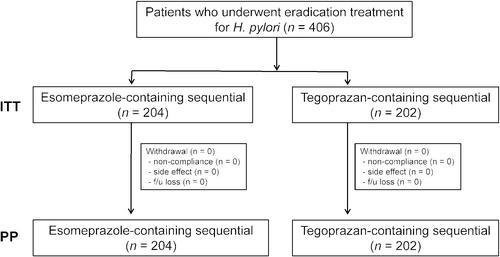Efficacy of Tegoprazan-Containing Sequential Eradication Treatment Compared to Esomeprazole-Containing Sequential Eradication of Helicobacter pylori in South Korea, a Region With High Antimicrobial Resistance: A Prospective, Randomized, Single Tertiary Center Study
Abstract
Background
Treatment with potassium-competitive acid blockers has shown acceptable efficacy in Helicobacter pylori eradication. In regions like Korea, where the clarithromycin resistance rate is high, alternative combinations like non-bismuth quadruple therapies have shown favorable results. This study compared the outcomes of sequential eradication therapy with new potassium-competitive acid blocker tegoprazan and conventional esomeprazole-containing sequential therapy.
Materials and Methods
Patients with Helicobacter pylori (H. pylori) infection were consecutively recruited. Patients were allocated to either an esomeprazole-containing sequential or a tegoprazan-containing sequential therapy group. Sequential therapy comprised esomeprazole (40 mg) or tegoprazan (50 mg) plus amoxicillin (1000 mg) twice daily for the initial 5 days, followed by esomeprazole (40 mg) or tegoprazan (50 mg) with clarithromycin (500 mg) and metronidazole (500 mg) twice daily for the remaining 5 days. Eradication rate, compliance, and adverse events were recorded.
Results
A total of 406 patients with H. pylori infection were enrolled in the trial and analyzed per protocol. Eradication rate by intention-to-treat and per-protocol was 83.8% (95% confidence interval [CI]: 78.7–88.9) for esomeprazole-containing sequential therapy, and 87.1% (95% CI: 82.5–91.8) for tegoprazan-containing sequential therapy, with no statistical significance (p = 0.399). Additionally, there was no statistically significant difference in treatment compliance between the two groups. Nausea was more prevalent (23.3%, 27/202) with sequential tegoprazans than with esomeprazole-containing sequential therapy (14.2%, 29/204; p = 0.022).
Conclusion
Tegoprazan-containing 10-day sequential eradication treatment demonstrated similar eradication efficacy compared to esomeprazole-containing treatment, even in regions with high antimicrobial resistance, such as Korea.
Trial Registration
ClinicalTrials.gov: NCT06382493


 求助内容:
求助内容: 应助结果提醒方式:
应助结果提醒方式:


